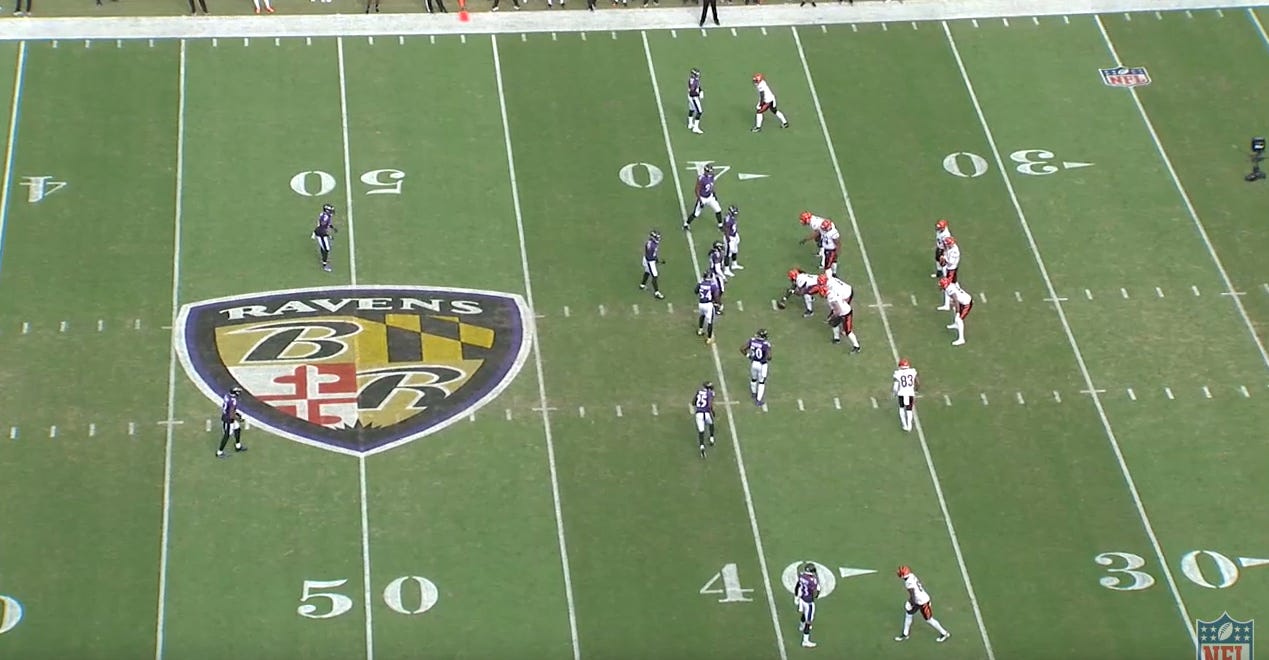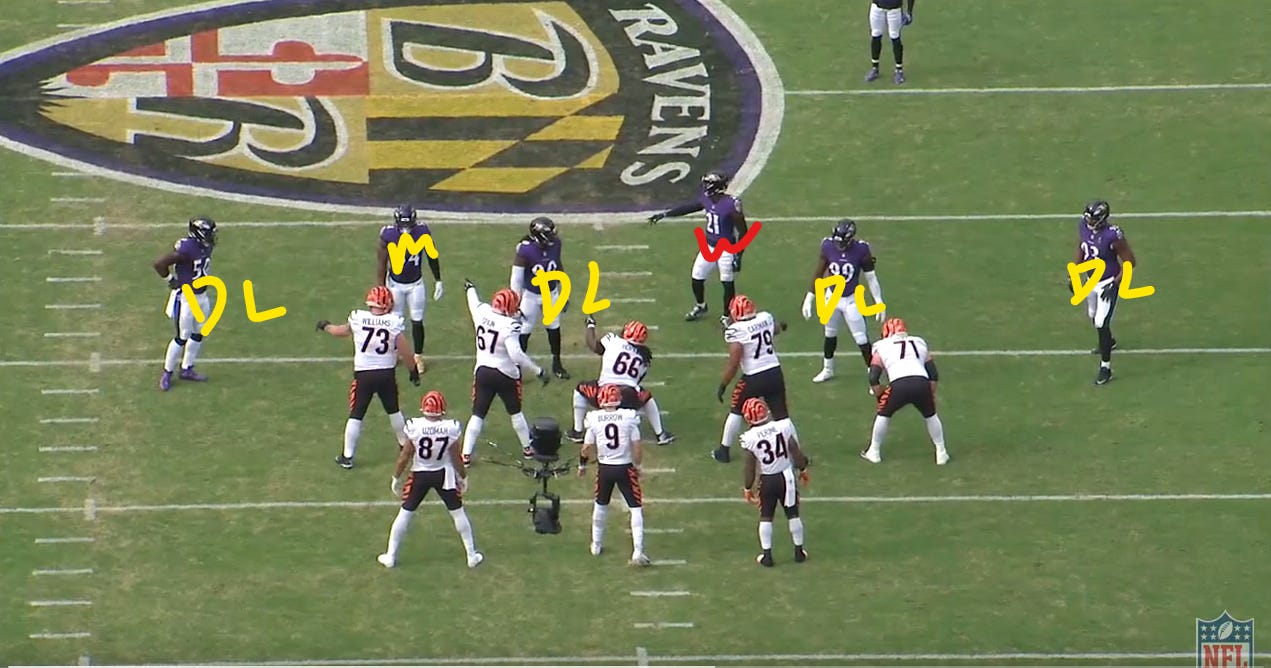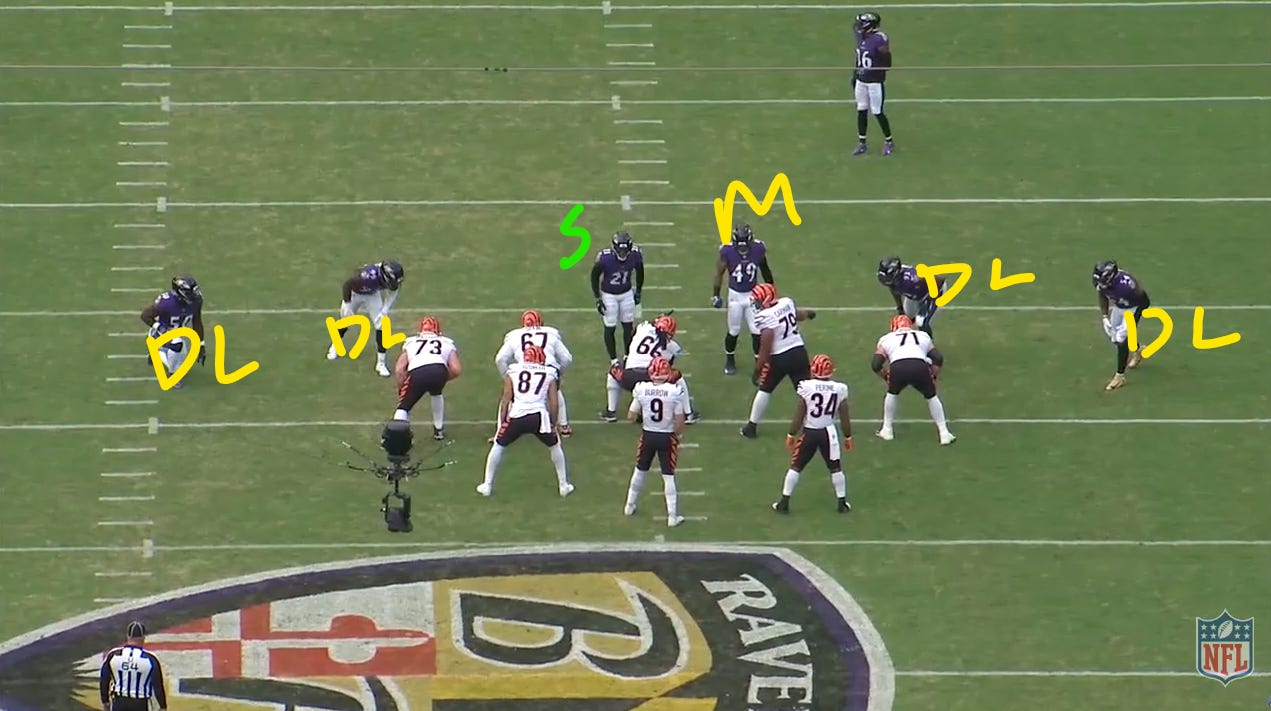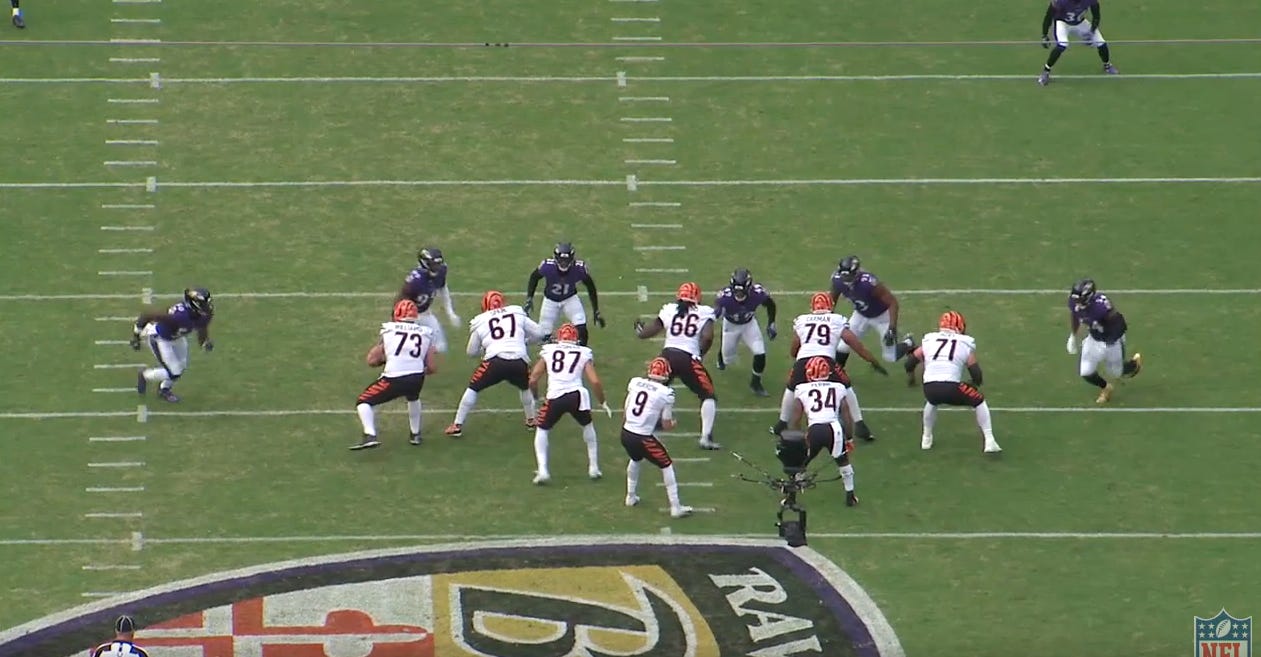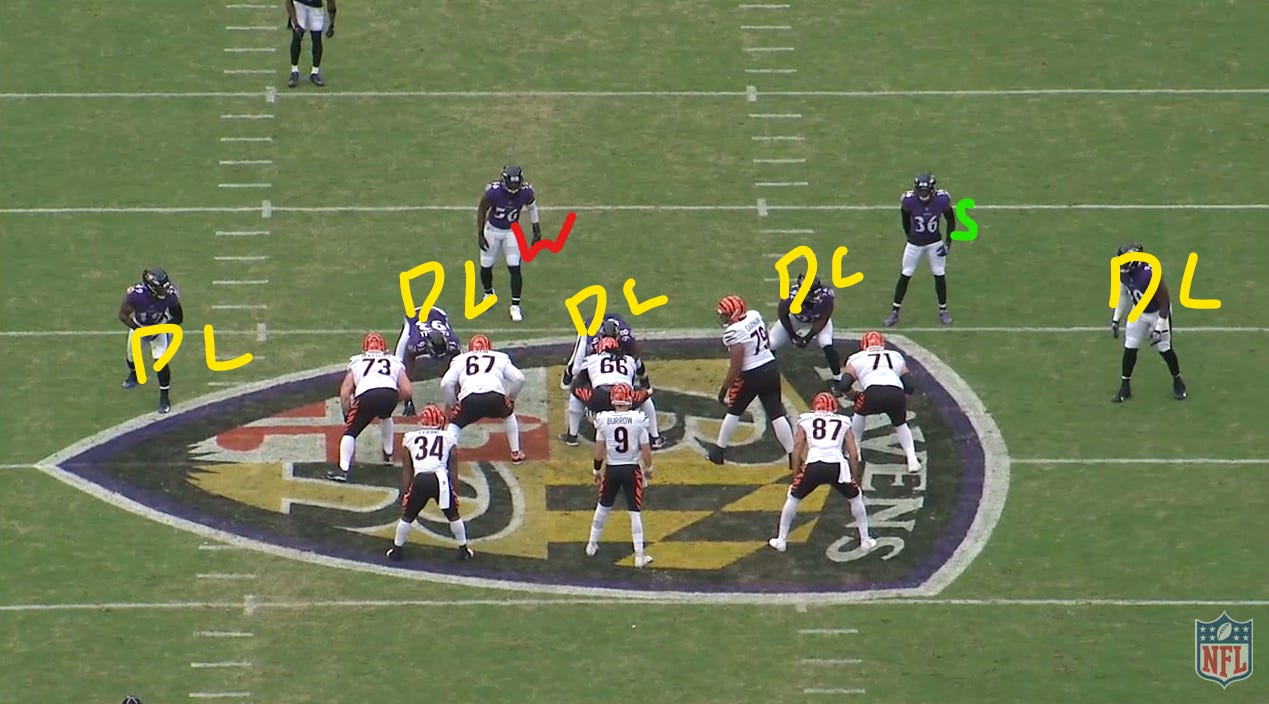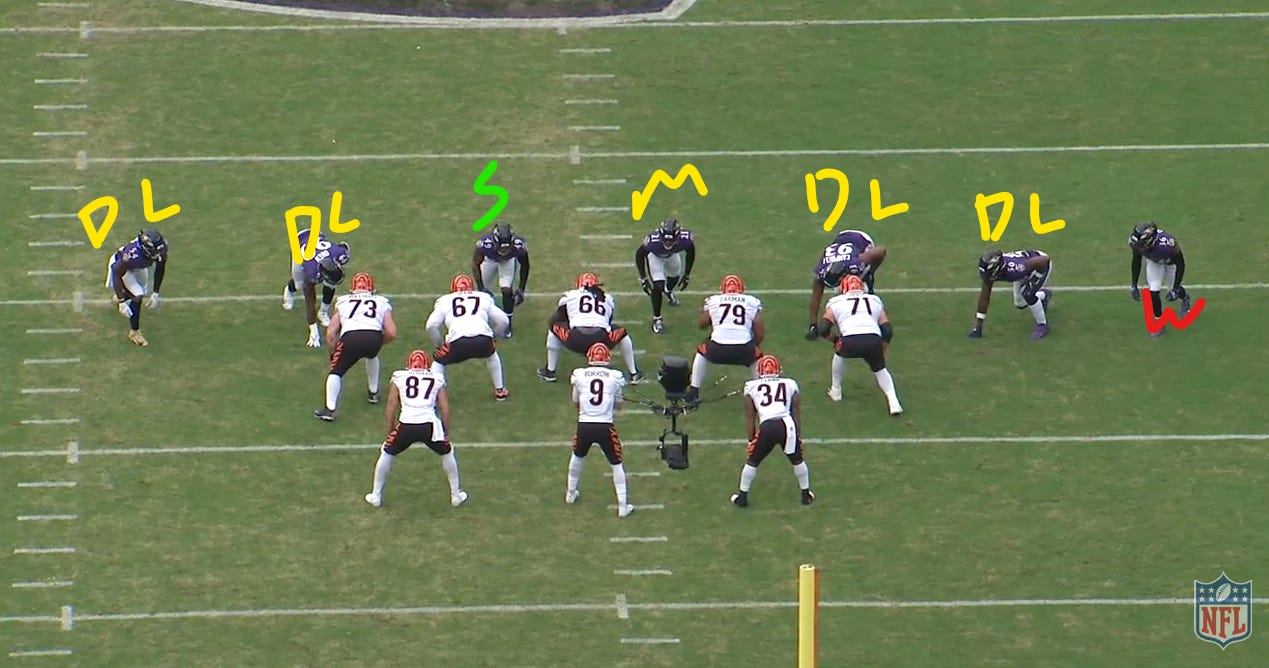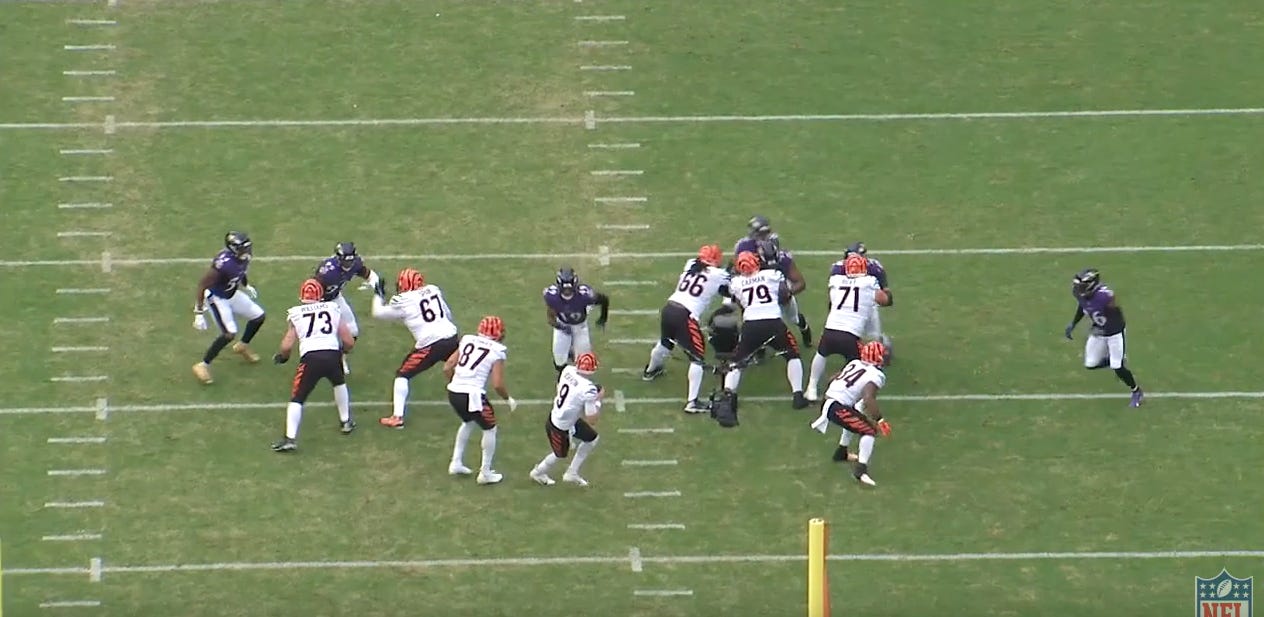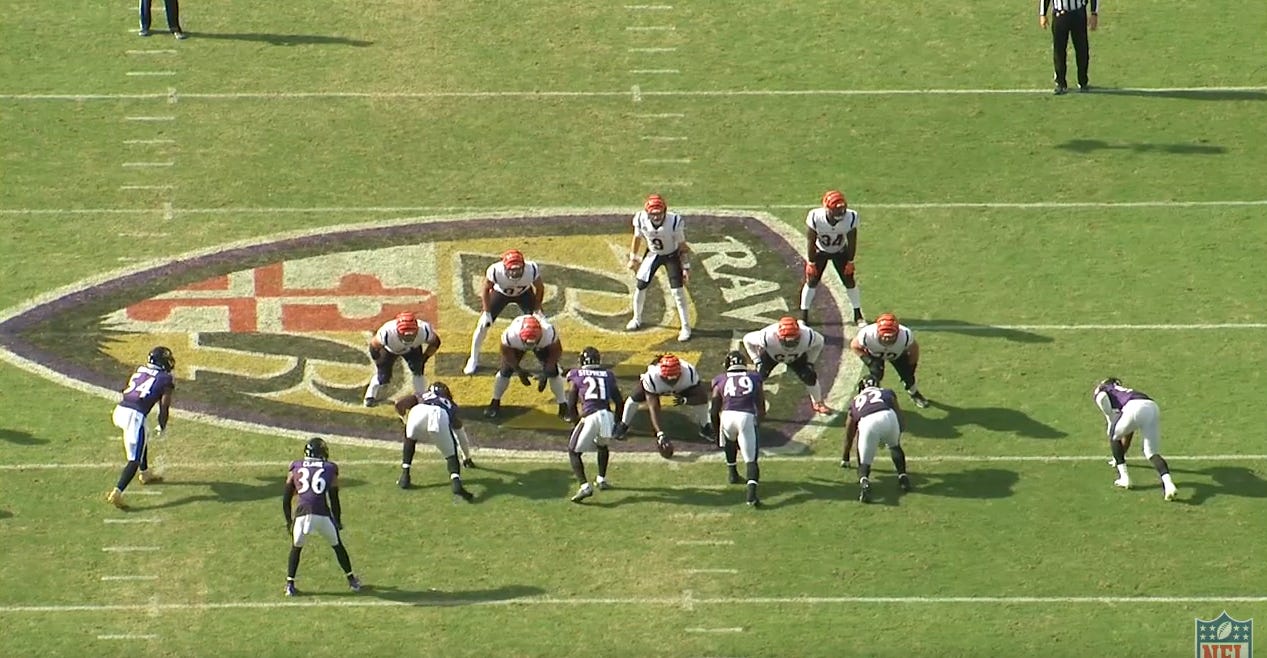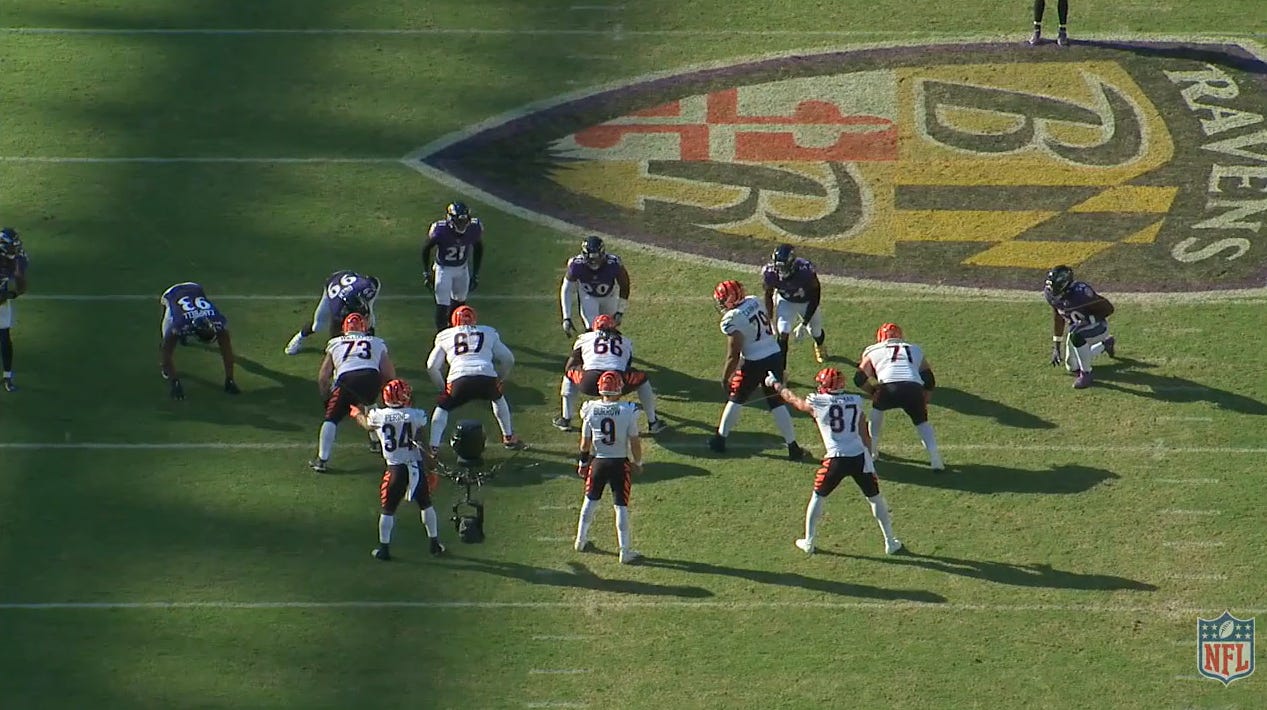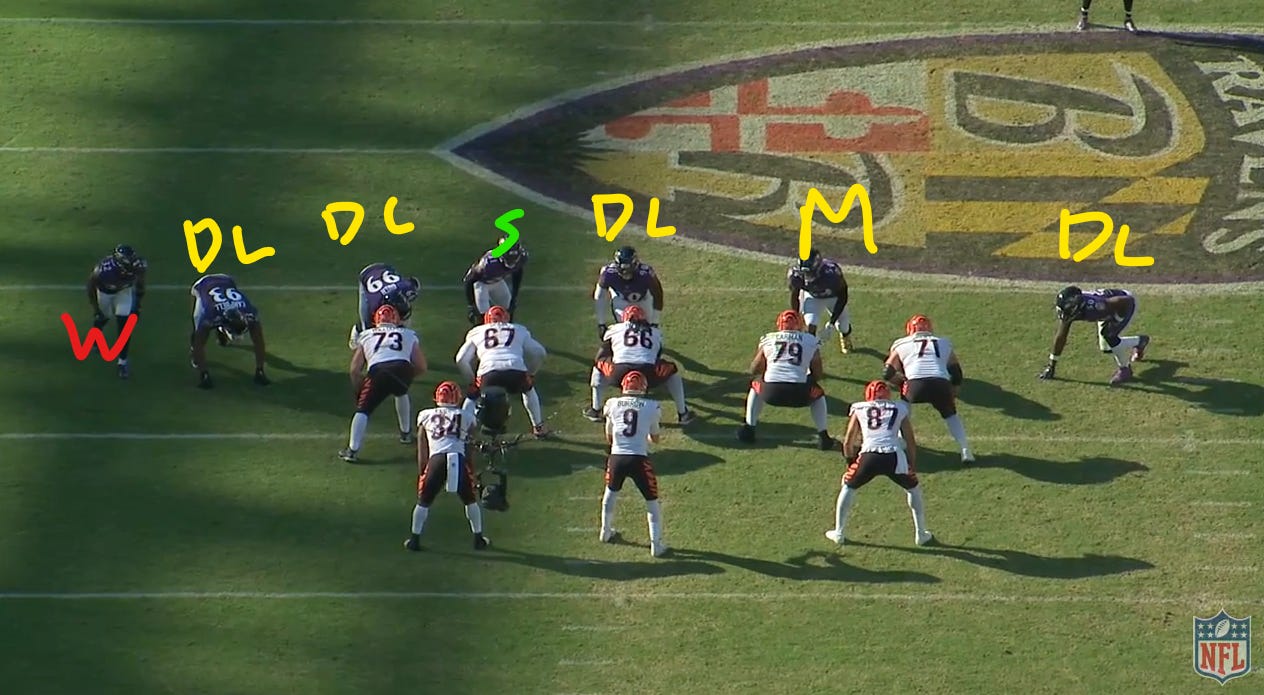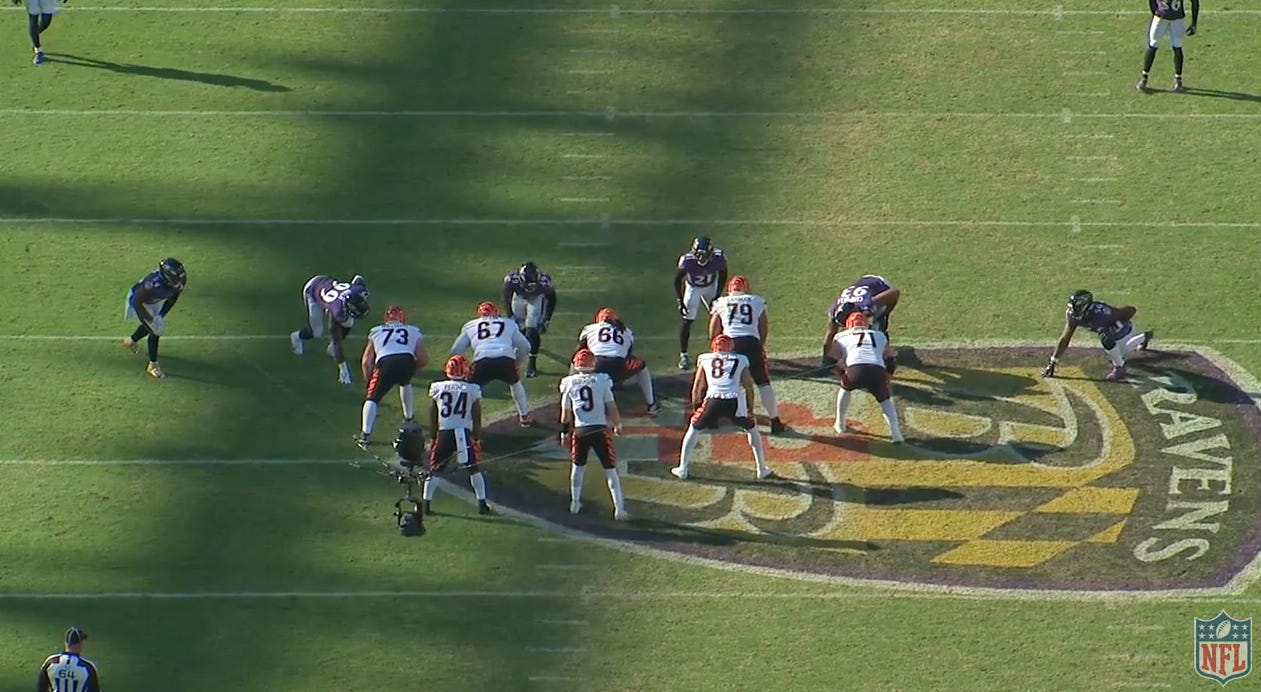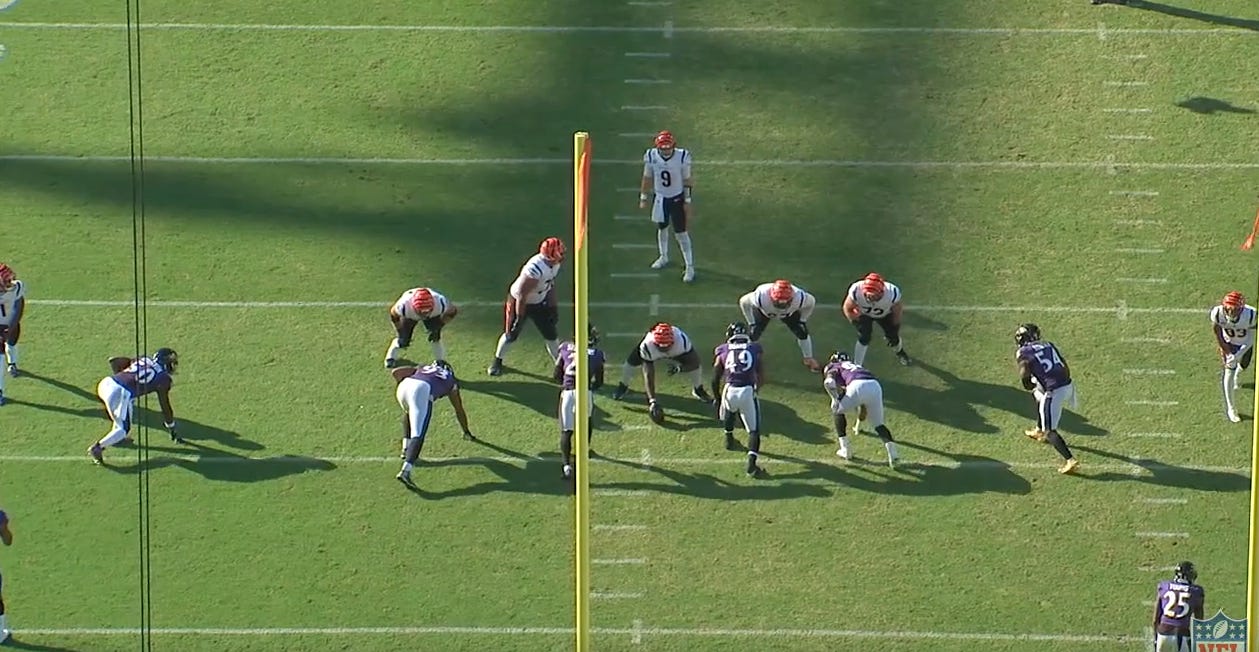A criticism I’ve had about the Cincinnati Bengals offense with Joe Burrow at QB was their reliance on Empty formations, especially in 3rd down situations. While operating from Empty in itself is not a crime - in face it’s a necessity for an NFL offense - the Bengals felt like it was limiting itself with a reliance on Burrow to make everything right.
Empty formations are a nice way to “clean up” the pre-snap reads for QBs. Defenders are forced to cover more ground with their disguises and at times align in a way that telegraphs their coverage (a LB all the way outside on a split out RB, for example).
Defenses counter Empty formations in a few ways. Sometimes they run a standard coverage call. But other times they have a check that drop 8 into coverage. Putting more bodies in throwing lanes anticipating the Quick Game concepts that typically come with those formations.
Other defenses like to bring pressure or keep their pressure calls on when countering Empty formations. Their line of thinking is to force the QB to be “Hot” and get rid of the ball quickly - either by an OL bust or just overwhelming the protection with numbers (or feigning those numbers). This is why there is so much pressure on 3rd down. Defenses want the QB to get rid of the ball quickly and then rally and tackle the receiver before the 1st down marker.
How does an offense bypass this and attack beyond the sticks? Sorting out protections is the first step, but sometimes the defense just brings a look that messes with standard protection rules. Good defenses especially (hello Mike Zimmer). Operating from Empty requires a quick-thinking QB and an OL that can consistently hold up and sort things out. But that is hard to do down-after-down.
Another way to attack defenses looking to heat up the QB is to keep blockers in and attacking with more vertical routes. A defensive coordinator is not going to like getting caught not only giving up 1st down conversions but explosive plays when their fun exotic look gets sorted out and blitzers are stuck at the line of scrimmage.
If you see what I’m getting at - or listened to the most recent episode of The Athletic Football Show I was on with Robert Mays - the Bengals utilized 7-man protections to great effect in their Week 7 win over the Baltimore Ravens. And not in a typical full slide “wad it up” way some offenses will use as a band-aid. A good gameplan also helped by impressive pocket movement from Joe Burrow to extend plays and allow the Bengals to actually aggressively attack a hyper-aggressive defense and this guy named Ja’marr Chase.
We got to see the Bengals gameplan vs. the Ravens pressure packages early & often.
This is the first 3rd down of the game for the Bengals offense:
With the outside CBs both pressed, this looks like a Man coverage look even before the Bengals put Tyler Boyd on a back-and-forth motion. The Safeties maintain a 2-high shell before rotating down, ending up in a Robber coverage.
What you’ll also notice on all of these plays is that the Bengals will be in the same Split Back formation look out of 11 personnel (1 RB, 1 TE, 3 WR). This is the typical formation for this protection, either with the TE back near the QB or in more of a “Y-Off” spot about a yard or two back off the line of scrimmage. Or out of 20 personnel with 2 RBs flanking the QB in the backfield.
Looking at this play from the endzone view. I’m sure you might be curious why I would use a clip that ends up in a free pass rusher and Burrow scrambling on an article about protections.
More than anything, I just wanted to use this clip to illustrate the protection rules for 7-man protection
The standard rules for a “Mike ID” 7-man protection plan are as follows:
OL - 4 “down linemen” and “Mike point”. With the Mike being the middle LB not by their actual position (although sometimes it is), but what ‘X’ they are on the chalkboard. Mike = Middle. Marked in yellow.
RB - The ‘X’ on the chalkboard that would be called the “Will”. Will = Weak. -1 from the middle. The RB would also have any other secondary pressures, say a FS blitzing. Marked in red.
TE - The ‘X’ on the chalkboard that would be called the “Sam”. Sam = Strong. +1 from the middle. The TE would also have any secondary pressures on his side. Marked in green.
With the coverage being 1 Robber, there is no blitz on this Ravens call. The pressure is created by the DL “game” that beats the Bengals RG Jackson Carman and RT Riley Reiff. You’ll also notice RB Samaje Perine get into a stalemate with #21 Brandon Stephens. Stephens has Perine in coverage and can add on as a blitzer if he thinks Perine is blocking. With Perine hesitating, Stephens ends up dropping his coverage responsibility. After Burrow pulls off a nifty pocket move to create a 1st down.
NEXT
On the next 3rd down. A slightly different look for the Ravens front. But they again run a Robber coverage with no blitzes.
Again not the greatest example to see versus an actual blitz, but you can see the routes called are deeper than in typical Empty formations. Some teams - like the Rams - like to create an Empty formation but then utilize chip help to buy an extra second for their deeper passing concepts to develop.
We also get another example for the rules of the 7-man protection. Yes, there will be a test at the end.
With Center Trey Hopkins making #49 the Mike, the rules unfold from there:
And post-snap you can see TE #87 Uzomah stepping for #21 before releasing on his route.
#34 Perine also does a great job with his eyes. You can see him checking to make sure nothing funky off the slot is coming *just in case* before releasing.
With #49 covering Perine in coverage and #21 on Uzomah. Both release on the routes and take the defenders with them.
The Bengals again went to the Split look on the following 4th & 1 and 3rd & 5 they faced in the 1st quarter. But again the RB & TE weren’t asked to hang in to protect:
This is a 5-down look. The OL takes the 5 “down” defenders, essentially making one of them the Mike. RB & TE have their off-ball duties per usual. This front was probably due to the 4th & 1 nature of the play, which makes the Bengals formation a little funny to see in this situation. And again, Perine gets into a stalemate with his man defender who can add-on:
And the 3rd & 5:
Again, no pressure except for the defender adding on to the TE blocking. We do see a varied coverage look from the Ravens. Creating a double on Boyd and having the Safety rotate down to Rob and then cover the RB.
And note the vertical routes from the Bengals. They are trusting their talented WRs to win down the field.
After nearly a full quarter of throwing jabs. Ravens defensive coordinator Wink Martindale started to rear back for some hooks and uppercuts.
This pressure is one that would give the standard rules of a 6-man protection issues. It brings 4 pass rushers (2 DL + Will + FS) towards the RB’s side, which would make it a straight number count problem. A great example of this was the Panthers against the Saints in Week 2. The coverage behind the pressure may have been different but you can see the issue arise (again and again):

How do you get the defense out of this? Well you can Empty it out and make defenders declare. Or adjust the protection - which takes a leap of faith or good film study.
OR you can protect with 7 and wad it all up:
That walked down FS on the edge of the line of scrimmage is the Will ‘X’ on the chalkboard.
At the snap of the ball, Perine’s defender (#21) aborts the rush thinking Perine is about to release into the flat as he takes his protection responsibility.
I’m not exactly sure why Uzomah acts like his controller unplugged, but he does (eventually) end up going to the right guy:
Burrow ends up spinning out and gets behind schedule on his throw due to Uzomah’s hesitation. But again the Bengals protectors sort out the pressure and lets them attack the defense vertically.
In a 2 minute situation in the 1st half (2 minute is essentially considered a passing down for NFL offenses & defenses. Like a 3rd down play.) We again get the double mugged look, again get a Robber coverage, but this time Stephens triggers right away. This was perhaps the Ravens coaches telling him to just go if he sees the Split Back look:
No drawings on this one, time for a practice example. Sort out who has who knowing the standard rules of a 7-man protection:
In the 2nd half and the Bengals growing their lead, Martindale starts bringing the exotics:
Tough one, right? You can even see Perine and Uzomah sorting it out before the snap:
Why is Uzomah pointing there? He’s supposed to have the Sam spot, right?
Another added rule/adjustment for this protection is the RB & TE having to be aware of 2 added rushers to a side of the Mike. This is why you have the TE off-ball, so he can adjust to either side if needed.
Perine was doing this earlier before releasing on his routes (the example where he peeked to the slot). And it requires the RB & TE to have good eyes in tracking on who potential threats could be.
It seems funky to be calling that the “Sam” spot but it’s best to not get too caught up in that.
A key to figuring out good rules for a protection is getting your protectors on “like bodies”. OL on DL/EDGE types and RB/TE on LB/DB. This is something to try and follow to get everyone on the right spot.
Post-snap, have to give credit to both RT Reiff for hanging in and not getting fooled by #54’s “Coffehouse” shenanigans. And also Uzomah for continuing to follow his rules and falling into the Slot pressure.
Burrow does a great job of stepping up in the pocket because he can step up in a clean pocket. The Bengals got lucky on the tipped ball but they did create their own luck with good process here.
The last Bengals Split Back example from the game came again in the 3rd quarter:
A look we’ve seen, perhaps a little more aggressive by the Ravens defenders.
Another example for practice:
The very last play I want to show is the only 3rd down where the Bengals were in an Empty formation. And it’s kind of funny to see them get reminded of a reason on why they perhaps shied away from it against the Ravens:
With no RB to help sort out the mugged up defenders, the Bengals are forced to slide the OL in a direction. The Ravens are bringing 6 defenders for 5 blockers so Burrow is essentially choosing which direction he wants to work away from.
He slides the OL to the right (watch #54 Tyus Bowser listen in on the call to hear which direction Burrow is going, too). Now that he has to throw Hot, he’s forced to drift in the pocket and the Ravens take advantage of knowing the ball is going to come out on 3rd & XL.
It was cool to see a team have a defined protection plan against a divisional opponent. And while some of the results of being in 7-man protection were mixed for the Bengals offense. The Bengals coached decided to stop letting the defense force them to do something like on that last clip. It’s just good process of having an actual plan for what the opponent likes to do in a key situation and getting to dictate what you want to do as an offense.
Various vibes today:



